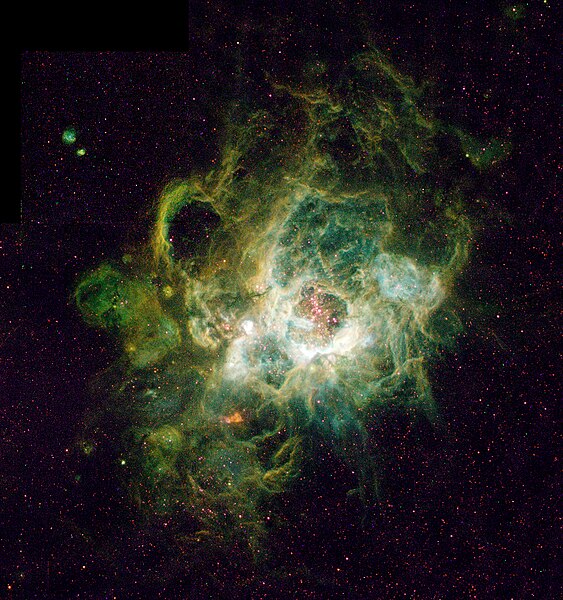Файл:Nursery of New Stars - GPN-2000-000972.jpg

Исходный файл (1127 × 1201 пкс, размер файла: 2,42 Мб, MIME-тип: image/jpeg)
Этот файл из на Викискладе и может использоваться в других проектах. Информация с его страницы описания приведена ниже.
|
Краткое описание
| ОписаниеNursery of New Stars - GPN-2000-000972.jpg |
English: This is a Hubble Space Telescope image (right) of a vast nebula called NGC 604, which lies in the neighboring spiral galaxy M33, located 2.7 million light-years away in the constellation Triangulum.
This is a site where new stars are being born in a spiral arm of the galaxy. Though such nebulae are common in galaxies, this one is particularly large, nearly 1,500 light-years across. The nebula is so vast it is easily seen in ground-based telescopic images (left). At the heart of NGC 604 are over 200 hot stars, much more massive than our Sun (15 to 60 solar masses). They heat the gaseous walls of the nebula making the gas fluoresce. Their light also highlights the nebula's three-dimensional shape, like a lantern in a cavern. By studying the physical structure of a giant nebula, astronomers may determine how clusters of massive stars affect the evolution of the interstellar medium of the galaxy. The nebula also yields clues to its star formation history and will improve understanding of the starburst process when a galaxy undergoes a "firestorm" of star formation. The image was taken on January 17, 1995 with Hubble's Wide Field and Planetary Camera 2. Separate exposures were taken in different colors of light to study the physical properties of the hot gas (17,000 degrees Fahrenheit, 10,000 degrees Kelvinമലയാളം: 2.7 ദശലക്ഷം പ്രകാശവർഷങ്ങൾക്കകലെ ത്രിഭുജം നക്ഷത്രരാശിയിൽ നിലകൊള്ളുന്ന ചുരുൾ താരാപാഥമായ M33-യിലെ NGC 604 എന്ന വലിയ നീഹാരികയുടെ ഹബിൾ ബഹിരാകാശ ദൂരദർശിനി എടുത്ത ചിത്രമാണിത്.
ഈ താരാപഥത്തിന്റെ ചുരുൾ ഭാഗങ്ങളിൽ നിന്നും പുതിയ നക്ഷത്രങ്ങൾ ജനിച്ചു കൊണ്ടിരിക്കുന്നു. താരാപഥങ്ങളിൽ ഇത്തരത്തിലുള്ള നീഹാരികകൾ സാധാരണമെങ്കിലും, ഇതിന്റെ അസാധാരണ വലിപ്പം, ഏകദേശം 1,500 പ്രകാശവർഷങ്ങൾ വ്യാപ്തി, ഇതിനെ പ്രമുഖമാക്കുന്നു. ഭൂമിയിൽ നിന്നും ദൂരദർശിനി ഉപയോഗിച്ച് എളുപ്പത്തിൽ കാണാവുന്നത്ര വലുതാണിത്. താരാപഥം NGC 604-ന്റെ കാമ്പിൽ 200 നക്ഷത്രങ്ങളെങ്കിലുമുണ്ട്, അവ സൂര്യനേക്കാളും വളരെ വലിയവയുമാണ് (സൗരപിണ്ഡം 15 മുതൽ 60 വരെ ആയിരിക്കും). അവ നീഹാരികയുടെ വായൂഭിത്തികളെ ചൂടുപിടിപ്പിക്കുകയും, പ്രകാശം ഉത്സർജ്ജിപ്പിക്കുകയും ചെയ്യുന്നു. അവയുടെ വെളിച്ചം, ഗുഹയ്ക്കുള്ളിലെ റാന്തൽ വിളക്കുപോലെ, നീഹാരികയുടെ ത്രിമാന ആകൃതി വെളിവാക്കാനും സഹായിക്കുന്നു. ഭീമൻ നെബൂലയുടെ ഭൗതിക രൂപം പഠിക്കുന്നതു വഴി ജ്യോതിശാസ്ത്രജ്ഞർക്ക്, എപ്രകാരമാണ് ഭീമൻ നക്ഷത്രങ്ങൾ താരാപഥങ്ങളിലെ അന്തർ ജ്യോതിർ മാദ്ധ്യമത്തിന്റെ പരിണാമത്തെ ബാധിക്കുന്നതെന്ന് മനസ്സിലാക്കാൻ സഹായിച്ചേക്കും. നക്ഷത്രസൃഷ്ടിയുടെ വേളകളിൽ താരാപഥങ്ങൾ കടന്നുപോകുന്ന "തീക്കൊടുങ്കാറ്റ്" അവസ്ഥയെക്കുറിച്ചും സ്റ്റാർബഴ്സ്റ്റ് പ്രക്രിയയെക്കുറിച്ചും ഉള്ള സൂചനകളും ഈ നീഹാരിക സൂചിപ്പിക്കുന്നുണ്ട്. ഈ ചിത്രം ഹബിളിന്റെ വൈഡ് ഫീൽഡ് ആൻഡ് പ്ലാനെറ്ററി കാമറ 2 ഉപയോഗിച്ച് 1995 ജനുവരി 17-നു എടുത്തതാണ്. നീഹാരികയിലെ ചൂടുവാതകങ്ങളുടെ (17,000 ഡിഗ്രി ഫാരൻഹീറ്റ്, 10,000 ഡിഗ്രി കെൽവിൻ) ഭൗതിക ഗുണങ്ങൾ പഠിക്കാനായി വ്യത്യസ്ത നിറങ്ങളിലുള്ള പ്രദർശിക്കപ്പെടലുകളും ചിത്രീകരണത്തിനു വിധേയമായിട്ടുണ്ട്.Español: Imagen, obtenida por el telescopio espacial Hubble, de la nebulosa NGC 604, en la galaxia del Triángulo, dentro de la constelación del triángulo, a unos 2.7 millones de años luz de nosotros. Al igual que otras nebulosas, NGC 604 es un criadero estelar, sólo que mucho mayor que otras, con unos 1,500 años luz de ancho; de hecho es la mayor región de hidrógeno ionizado conocida. |
| Дата | |
| Источник | |
| Автор | Hui Yang (University of Illinois) and NASA/ESA |
Это изображение или видеозапись внесены в каталог Института исследований космоса с помощью космического телескопа НАСА под идентификатором (Photo ID): GPN-2000-000972 и под альтернативным идентификатором: PR96-27B. Этот шаблон не указывает на правовой статус данной работы. По-прежнему необходим нормальный шаблон лицензий. См. Commons:Лицензирование. Другие языки:
العربية ∙ беларуская (тарашкевіца) ∙ български ∙ català ∙ čeština ∙ dansk ∙ Deutsch ∙ English ∙ español ∙ فارسی ∙ français ∙ galego ∙ magyar ∙ հայերեն ∙ Bahasa Indonesia ∙ italiano ∙ 日本語 ∙ македонски ∙ മലയാളം ∙ Nederlands ∙ polski ∙ português ∙ русский ∙ sicilianu ∙ slovenščina ∙ Türkçe ∙ українська ∙ 简体中文 ∙ 繁體中文 ∙ +/− |
Лицензирование
| Public domainPublic domainfalsefalse |
| This file is in the public domain because it was created by NASA and ESA. NASA Hubble material (and ESA Hubble material prior to 2009) is copyright-free and may be freely used as in the public domain without fee, on the condition that only NASA, STScI, and/or ESA is credited as the source of the material. This license does not apply if ESA material created after 2008 or source material from other organizations is in use. The material was created for NASA by Space Telescope Science Institute under Contract NAS5-26555, or for ESA by the Hubble European Space Agency Information Centre. Copyright statement at hubblesite.org or 2008 copyright statement at spacetelescope.org. For material created by the European Space Agency on the spacetelescope.org site since 2009, use the {{ESA-Hubble}} tag. |
Краткие подписи
Элементы, изображённые на этом файле
изображённый объект
17 января 1995
image/jpeg
История файла
Нажмите на дату/время, чтобы увидеть версию файла от того времени.
| Дата/время | Миниатюра | Размеры | Участник | Примечание | |
|---|---|---|---|---|---|
| текущий | 21:12, 8 августа 2019 |  | 1127 × 1201 (2,42 Мб) | BevinKacon | Reverted to version as of 01:11, 9 April 2009 (UTC) bad upscale by new user |
Использование файла
Следующие 2 страницы используют этот файл:
Метаданные
Файл содержит дополнительные данные, обычно добавляемые цифровыми камерами или сканерами. Если файл после создания редактировался, то некоторые параметры могут не соответствовать текущему изображению.
| Название изображения | converted PNM file |
|---|---|
| Версия IIM | 2 |
| Примечание JPEG-файла | File written by Adobe Photoshop¨ 5.0 |
